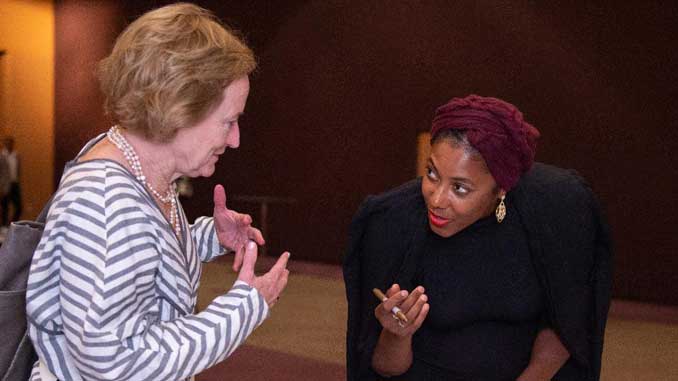
Edward Carter III Data News Weekly Contributor
Growing up in a large household in New Orleans East was nothing but normal for author, Sarah Broom. The youngest of 12 children, she was entertained in the densely populated rooms of her family’s “Yellow House” at 4121 Wilson Avenue, off Chef Menteur Highway. It taught her to appreciate solitude. Broom spent her childhood looking for an adequate mode of self-expression. It took her 8 years to document what it meant to grow up in the East in the acclaimed book “The Yellow House” released on August 13, 2019.
“Because I grew up with so many siblings, there is a feeling you start to get used to. Having a lot of characters around you, it made me who I am, and I don’t have any other concept of living any other way,” said Broom, whose memoir has become a New York Times bestseller.
The book is a painstakingly detailed journey into several decades of pre-and post-Katrina life in the East, a quadrant of the city that Broom remarks feels as if it is cut off after the high-rise of the Industrial Canal, and now forgotten and abandoned after the storm. Her family home her mother purchased at the age of 19 was demolished in 2016, and her book now stands as testimony of not just her own story but those of many families of the East. In reliving memories, Broom shared that she wanted the book to balance both the joys and challenges of growing up in New Orleans East.
“I love New Orleans for all the things that makes it a great city, but New Orleans also has major dysfunctions. I think it is impossible to say you love a person or a place and not look upon that person or place with honesty,” said Broom to a packed University Ballroom on Xavier University’s campus, where she was the featured speaker for the Provost Lecture Series on September 11, 2019, and moderated by Xavier Mass Communication Professor Shearon Roberts.
In 2005, Hurricane Katrina damaged the “yellow house” she grew up in and in the decade since the storm, New Orleans East remained neglected and abandoned. This tragedy made it emotionally uneasy for Broom to come back and visit her hometown, but when writing the book “The Yellow House,” she knew that she wanted to push past the baseline of what people expected a memoir to be and create an entertaining work of literary forms.
“Thinking about what the loss of that house actually means. It’s more than just a place missing from the surface. There are stories that the house tells. These are people’s legacies gone, these are people’s stories gone,” she said.
Broom shared in her book and with the public that she finds it disturbing to discover that New Orleans East has been missing from so many stories about the city, and about the wider narrative about what it means to be a New Orleanian. Broom always wondered how a place that is 50-times the French Quarter in size, is rarely identifiable on a map. New Orleans East is a familiar sort for many Black families in New Orleans, she shared, and an integral part of Black history in the city but is little known to the rest of New Orleans and to outsiders. This gave Broom more motivation to learn and explore the history of her home.
“I think what helped me was that I did a lot of interviews with my family. So, I visited all of them, explained the project of the book, and over the course of the years I collected hundreds of hours of interviews with them,” Broom said of the journey to uncover little known histories or stories. She described the effort of producing the book as challenging the History 101 of a place, knowing that many histories had left this part of the city out.
“There were moments when things were very personal and, in those moments, I would ask. I really felt the stories they told me I needed to tell this story and I would just simply get their permission,” she said.
The book has come to resonate with readers across the country as people come to understand the impacts of loss, particularly from disasters, or simply the nostalgia of moving away from one’s childhood home.
“[The book] really opened our eyes and showed how Katrina and how life in New Orleans changed after that. A lot of rebuilding and the city is still rebuilding and just to sustain society,” said Royce Hooks, a Xavier student who attended the event.
“Me personally not being from New Orleans and a lot of people at Xavier. We really don’t know about the full history behind Katrina and New Orleans East,” Hooks said.
Broom’s purpose for writing this novel was to trace the history and put New Orleans East back into the discussion of who and what makes this city, said Dr. Ja’Wanda Grant, a Special Assistant to the Provost in Xavier’s Academic Affairs office, and who organized the public event. Her journey in writing this novel took strategic planning with it being a story that consists of her family, but ultimately resulted in regaining a sense of home for an entire community whose houses may no longer be standing, but whose hearts will always be rooted in the idea of “home.”
“I think it was very serendipitous because she had written this book about memories about a place in history, and what it meant to her. And it just so happened that it was New Orleans,” Grant said.
Recommended For You.



Be the first to comment